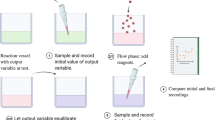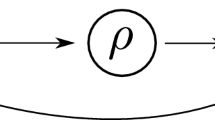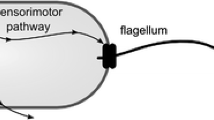Abstract
A biological system achieves homeostasis when there is a regulated quantity that is maintained within a narrow range of values. Here, we consider homeostasis as a phenomenon of network dynamics. In this context, we improve a general theory for the analysis of homeostasis in network dynamical systems with distinguished input and output nodes, called ‘input–output networks.’ The theory allows one to define ‘homeostasis types’ of a given network in a ‘model independent’ fashion, in the sense that the classification depends on the network topology rather than on the specific model equations. Each ‘homeostasis type’ represents a possible mechanism for generating homeostasis and is associated with a suitable ‘subnetwork motif’ of the original network . Our contribution is an extension of the theory to the case of networks with multiple input nodes. To showcase our theory, we apply it to bacterial chemotaxis, a paradigm for homeostasis in biochemical systems. By considering a representative model of Escherichia coli chemotaxis, we verify that the corresponding abstract network has multiple input nodes. Thus showing that our extension of the theory allows for the inclusion of an important class of models that were previously out of reach. Moreover, from our abstract point of view, the occurrence of homeostasis in the studied model is caused by a new mechanism, called input counterweight homeostasis. This new homeostasis mechanism was discovered in the course of our investigation and is generated by a balancing between the several input nodes of the network—therefore, it requires the existence of at least two input nodes to occur. Finally, the framework developed here allows one to formalize a notion of ‘robustness’ of homeostasis based on the concept of ‘genericity’ from the theory dynamical systems. We discuss how this kind of robustness of homeostasis appears in the chemotaxis model.








Similar content being viewed by others
References
Alon, U., Surette, M.G., Barkai, N., Leibler, S.: Robustness in bacterial chemotaxis. Nature 397, 168–171 (1999)
Ang, J., McMillen, D.R.: Physical constraints on biological integral control design for homeostasis and sensory adaptation. Biophys. J. 104(2), 505–515 (2013)
Antoneli, F., Golubitsky, M., Stewart, I.: Homeostasis in a feed forward loop gene regulatory motif. J. Theor. Biol. 445, 103–109 (2018)
Aoki, S.K., Lillacci, G., Gupta, A., Baumschlager, A., Schweingruber, D., Khammash, M.: A universal biomolecular integral feedback controller for robust perfect adaptation. Nature 570(7762), 533–537 (2019)
Araujo, R.P., Liotta, L.A.: The topological requirements for robust perfect adaptation in networks of any size. Nat. Commun. 9(1), 1757 (2018)
Barkai, N., Leibler, S.: Robustness in simple biochemical networks. Nature 387, 913–917 (1997)
Berg, H.C.: Escherichia coli in Motion. Springer, Berlin (2004)
Best, J.A., Nijhout, H.F., Reed, M.C.: Homeostatic mechanisms in dopamine synthesis and release: a mathematical model. Theor. Biol. Med. Modell. 6(1), 21 (2009)
Brualdi, R.A., Ryser, H.J.: Combinatorial Matrix Theory. Cambridge University Press, Cambridge (1991)
Clausznitzer, D., Oleksiuk, O., Løvdok, L., Sourjik, V., Endres, R.G.: Chemotactic response and adaptation dynamics in Escherichia coli. PLoS Comput. Biol. 6(5), 1–11 (2010)
Edgington, M.P., Tindall, M.J.: Understanding the link between single cell and population scale responses of Escherichia coli in differing ligand gradients. Comp. Struct. Biotech. J. 13, 528–538 (2015)
Edgington, M.P., Tindall, M.J.: Mathematical analysis of the Escherichia coli chemotaxis signalling pathway. Bull. Math. Biol. 80(4), 758–787 (2018)
Enciso, G.A.: Transient absolute robustness in stochastic biochemical networks. J. R. Soc. Interface 13(121), 20160475 (2016)
Ermentrout, G.B.: Simulating, analyzing, and animating dynamical systems: a guide to XPPAUT for researchers and students. SIAM (2002)
Golubitsky, M., Stewart, I.: Nonlinear dynamics of networks: the groupoid formalism. Bull. Am. Math. Soc. 43(3), 305–364 (2006)
Golubitsky, M., Stewart, I.: Homeostasis, singularities, and networks. J. Math. Biol. 74(1–2), 387–407 (2017)
Golubitsky, M., Stewart, I.: Homeostasis with multiple inputs. SIAM J. Appl. Dyn. Syst. 17(2), 1816–1832 (2018)
Golubitsky, M., Stewart, I., Antoneli, F., Huang, Z., Wang, Y.Y.: Input–output networks, singularity theory, and homeostasis. In: Junge, O., Ober-Blobaum, S., Padburg-Gehle, K., Froyland, G., Schütze, O. (eds) Advances in Dynamics, Optimization and Computation, pp. 36–65. Springer Cham (2020)
Hansen, C.H., Endres, R.G., Wingreen, N.S.: Chemotaxis in Escherichia coli: a molecular model for robust precise adaptation. PLOS Comp. Biol., 4(1), e1, 01 (2008)
Kitano, H.: Biological robustness. Nat. Rev. Genet. 5(11), 826–837 (2004)
Kitano, H.: Towards a theory of biological robustness. Mol. Syst. Biol. 3(1), 137 (2007)
Kollmann, M., Løvdok, L., Bartholomé, K., Timmer, J., Sourjik, V.: Design principles of a bacterial signalling network. Nature 438(7067), 504–507 (2005)
Ma, W., Trusina, A., El-Samad, H., Lim, W.A., Tang, C.: Defining network topologies that can achieve biochemical adaptation. Cell 138(4), 760–773 (2009)
Marquez-Lago, T.T., Leier, A.: Stochastic adaptation and fold-change detection: from single-cell to population behavior. BMC Syst. Biol. 5(1), 1–16 (2011)
Mello, B.A., Tu, Y.: Perfect and near-perfect adaptation in a model of bacterial chemotaxis. Biophys. J. 84(5), 2943–2956 (2003)
Modell, H., Cliff, W., Michael, J., McFarland, J., Wenderoth, M.P., Wright, A.: A physiologist’s view of homeostasis. Adv. Physiol. Educ. 39(4), 259–66 (2015)
Nijhout, H.F., Best, J., Reed, M.C.: Escape from homeostasis. Math. Biosci. 257, 104–110 (2014)
Nijhout, H.F., Best, J., Reed, M.C.: Systems biology of robustness and homeostatic mechanisms. WIREs Syst. Biol. Med., p. e1440, (2018)
Nijhout, H.F., Best, J.A., Reed, M.C.: Using mathematical models to understand metabolism, genes and disease. BMC Biol. 13, 79 (2015)
Nijhout, H.F., Reed, M.C.: Homeostasis and dynamic stability of the phenotype link robustness and plasticity. Integr. Comp. Biol. 54(2), 264–75 (2014)
Nijhout, H.F., Reed, M.C., Budu, P., Ulrich, C.M.: A mathematical model of the folate cycle: new insights into folate homeostasis. J. Biol. Chem. 279, 55008–55016 (2004)
Reed, M., Best, J., Golubitsky, M., Stewart, I., Nijhout, H.F.: Analysis of homeostatic mechanisms in biochemical networks. Bull. Math. Biol. 79(11), 2534–2557 (2017)
Schneider, H.: The concepts of irreducibility and full indecomposability of a matrix in the works of Frobenius, König and Markov. Lin. Alg. Appl. 18, 139–162 (1977)
Tang, Z.F., McMillen, D.R.: Design principles for the analysis and construction of robustly homeostatic biological networks. J. Theor. Biol. 408, 274–289 (2016)
Thom, R.: Topological models in biology. Topology 8, 313–335 (1969)
Tindall, M., Porter, S., Maini, P., Armitage, J.: Overview of mathematical approaches used to model bacterial chemotaxis II: bacterial populations. Bull. Math. Biol. 70(6), 1570–1607 (2008)
Tindall, M., Porter, S., Maini, P., Gaglia, G., Armitage, J.: Overview of mathematical approaches used to model bacterial chemotaxis I: The single cell. Bull. Math. Biol. 70(6), 1525–1569 (2008)
Wang, Y., Huang, Z., Antoneli, F., Golubitsky, M.: The structure of infinitesimal homeostasis in input–output networks. J. Math. Biol. 82, 62 (2021)
Yi, T.M., Huang, Y., Simon, M.I., Doyle, J.: Robust perfect adaptation in bacterial chemotaxis through integral feedback control. Proc. Natl. Acad. Sci. U.S.A. 97, 4649–4653 (2000)
Acknowledgements
We thank Martin Golubitsky, Yangyang Wang, Zhengyuan Huang, Pedro P. A. C. Andrade and Misaki Yamada for helpful conversations. The research of JLOM and FA was supported by Fundação de Amparo à Pesquisa do Estado de São Paulo (FAPESP) Grant 2019/12247-7. JLOM is also supported by a scholarship from the EPSRC Centre for Doctoral Training in Statistical Applied Mathematics at Bath (SAMBa), under the project EP/S022945/1.
Author information
Authors and Affiliations
Corresponding author
Additional information
Communicated by Paul Newton.
Publisher's Note
Springer Nature remains neutral with regard to jurisdictional claims in published maps and institutional affiliations.
Appendices
Appendices
Irreducibility of Homogeneous Polynomials
In this appendix, we prove general results about irreducibility of certain homogeneous polynomials that are used in Sect. 3 and Appendix C.
Lemma A.1
Let \(P(y_{1}, y_{2}, \ldots , y_{n})\) be a homogeneous polynomial of degree 1, i.e.,
then, a polynomial \(Q(y_{1}, y_{2}, \ldots , y_{n})\) divides P iff either \(Q(y_{1}, y_{2}, \ldots , y_{n}) \equiv b_{0}\) and \(b_{0}\) divides each term \(a_{i}\), for all \(i = 1,\ldots ,n\), or there is a coefficient c such that
and \(a_{i} = c \cdot b_{i}\), for all \(i = 1,\ldots ,n\).
Proof
(\(\Leftarrow \)) It is straightforward to see that in both cases Q divides P.
(\(\Rightarrow \)) Suppose that a polynomial \(Q(y_{1}, y_{2}, \ldots , y_{n})\) divides P. As P is a homogeneous polynomial of degree 1, then Q must have at most degree 1, i.e., we can explicitly write Q as
Moreover, there is a polynomial \(R(y_{1}, y_{2}, \ldots , y_{n})\) such that \(P \equiv QR\). By the same argument, we can explicitly write R as
From (B.5), we conclude:
From (B.6), we have \(b_{0} = 0\) or \(c_{0} = 0\). Suppose that \(b_{0} = 0\). Therefore, by (B.3), we get
Taking \(b_{0} = 0\) in (B.6), we get
Considering \(c_{0} \equiv c\), one of the cases of the lemma is obtained. Suppose now that \(c_{0} = 0\). In that case, by (B.6), we get
and therefore, as \(a_{i} \ne 0\), then \(c_{i} \ne 0\). However, we must satisfy \(b_{i}c_{i} = 0\), for all \(i = 1,\ldots ,n\). Therefore, we conclude that \(b_{i} = 0\), for all \(i = 1,\ldots ,n\), which means that
From (B.9), we have that \(b_{0}\) divides each term \(a_{i}\), for all \(i = 1,\ldots ,n\). \(\square \)
Corollary A.2
Let \(P(y_{1}, y_{2}, \ldots , y_{n})\) be a homogeneous polynomial of degree 1, i.e.,
such that \(a_{1}, \ldots , a_{n}\) do not share common factors. Then P is irreducible.
Proof
Suppose there is a polynomial \(Q(y_{1}, y_{2}, \ldots , y_{n})\) which is a divisor of P. By Lemma A.1, there is a coefficient c that divides every term \(a_{i}\). As \(a_{1}, \ldots , a_{n}\) do not share common factors, \(c = \pm 1\), and hence, either \(Q(y_{1}, y_{2}, \ldots , y_{n}) \equiv \pm 1\) or \(Q(y_{1}, y_{2}, \ldots , y_{n}) \equiv \pm P(y_{1}, y_{2}, \ldots , y_{n})\). That is, P is irreducible. \(\square \)
Non-Triviality of the Homeostasis Determinant
In this appendix, we prove the claim that if the self-couplings are not identically zero and the output node is downstream from all input nodes (see Remark 2.8), then \(\det \langle H \rangle \) is not identically zero.
Let f be a smooth admissible vector field associated to a network \({\mathcal {G}}\) and denote by J its Jacobian matrix. Let \({\mathcal {G}}\) be composed by nodes \(\sigma _{1}, \sigma _{2}, \ldots , \sigma _{n}\). Then
where \(f_{\sigma _{i}, \sigma _{j}}\) denote the partial derivatives of f. We say that f or J is generic if the following conditions are satisfied:
-
(a)
\(f_{\sigma _{i}, \sigma _{j}} \equiv 0\) if and only if there is no arrow \(\sigma _{j} \rightarrow \sigma _{i}\).
-
(b)
there is no polynomial relation among \(f_{\sigma _{i}, \sigma _{j}}\).
This means that \(f_{\sigma _{i}, \sigma _{j}}\) may be seen as algebraically independent variables and the J may be seen as a ‘decorated’ adjacency matrix of \({\mathcal {G}}\). In particular, \(\det J\) (or the determinant of any sub-matrix of J) may be seen as a polynomial on the algebraically independent variables \(f_{\sigma _{i}, \sigma _{j}}\) and thus it vanishes identically if and only if all its summands are identically zero (see Brualdi and Ryser (1991)). Note that the set of generic admissible vector fields f is an open set in any appropriate topology on the space of all smooth admissible vector fields.
Lemma B.1
If all the self-couplings of a generic Jacobian matrix J are not identically zero (i.e., \(f_{\sigma _{i}, \sigma _{i}} \not \equiv 0\)) then \(\det J\) is not identically zero.
Proof
Let \({\mathcal {G}}\) be a network with n nodes \(\sigma _{1}, \sigma _{2}, \ldots , \sigma _{n}\). Consider the product of diagonal elements of J:
First of all, it is a summand of \(\det J\). Moreover, because f (and hence J) is generic and all the self-couplings are not identically zero, the product is not identically zero. Therefore, we conclude that \(\det J\) cannot be identically zero. \(\square \)
Proposition B.2
Let \({\mathcal {G}}\) be an input–output network with input node \(\iota \) and output node o such that o is downstream from \(\iota \). Suppose that J is generic and all its self-couplings are not identically zero. Then, the determinant of the corresponding homeostasis matrix H is not identically zero.
Proof
By Lemma B.1 and (Wang et al. 2021, Thm 2.4), it is enough to consider the case when \({\mathcal {G}}\) is a core input–output network with n nodes. Since the output node o is downstream from the input node \(\iota \) there is a directed path S between them
We can assume, without loss of generality, that the directed path S is \(\iota o\)-simple. Let \(\sigma _{k+1},\ldots ,\sigma _{n-2}\) be the remaining (regulatory) nodes of the network that are not in S. Consider the following product of partial derivatives of a generic admissible vector field f:
This product has \(n-1\) factors, each one belonging to a unique row and column of the Jacobian matrix J. We claim that it is one of the summands of \(\det H\). Indeed, the homeostasis matrix H is obtained from the Jacobian matrix J by dropping the first row and the last column, that is, elements of the form \(f_{\iota ,\cdot }\) and \(f_{\cdot ,o}\), respectively. Since none of these elements are in the product above, it follows that the claim is true. Because f (and hence J) is generic and all the self-couplings are not identically zero, the product is not identically zero. Therefore, we conclude that \(\det H\) cannot be identically zero. \(\square \)
Proposition B.3
Let \({\mathcal {G}}\) be a network with input nodes \(\iota _{1}, \ldots , \iota _{n}\) and output node o such that o is downstream from every input node. Suppose that J is generic and all its self-couplings are not identically zero. Then, the determinant of the corresponding weighted homeostasis matrix \(\langle H \rangle \) is not identically zero.
Examples of networks that do not satisfy the assumptions of nonzero self-couplings and/or the output node is not downstream from the input node(s). With the existence of nodes that are not self-coupled (cases (a) and (c)) the determinant of the (weighted) homeostasis matrix may vanish identically either in the case of only one input node (a) or when there exist multiple input nodes (c). In the case the output node is not downstream from the input node(s), in b it is trivial to see that \(\det H 0\). In (d), the network has input nodes \(\iota _{1}\) and \(\iota _{2}\), and the output node o is not downstream from \(\iota _{2}\). In that case \(\det H \not \equiv 0\), but the dynamics of o does not depend on the dynamics of \(\iota _{2}\). Finally, in all these examples the eigenvalues of the Jacobian are non-trivial, and therefore, the network may display a linearly stable equilibrium, depending on the specific model that it represents
Proof
By Lemma B.1 and Eq. (3.12), it is enough to prove the claim when \({\mathcal {G}}\) is a core network. As shown in Sect. 3.4, \(\det \langle H \rangle \) can be factorized as a product of common factors between each of the determinants \(\det H^{c}_{\iota _{m}}\) and the input counterweight term. By Proposition B.2, none of these common factors can be identically zero. This means that \(\det \langle H \rangle \) is identically zero if, and only if, the input counterweight term is identically zero. Recall that the input counterweight term is irreducible and its expression is given by Eq. (3.34). By hypothesis, \(f_{\iota _{m}, {\mathcal {I}}}\) is always nonzero and Lemma B.1 implies that the determinants \(\det (J_{{\mathcal {D}}_{m}})\) must be all nonzero. Moreover, as each determinant \(\det (C_{\iota _{m}})\) is a factor of \(\det H^{c}_{\iota _{m}}\), then, by Proposition B.2, we conclude that \(\det (C_{\iota _{m}})\) cannot be identically zero for all \(1 \le m \le n\). Hence, as \(\det C\) is irreducible, we conclude that it cannot be identically zero. Therefore, \(\det \langle H \rangle \) is not identically zero. \(\square \)
Remark B.1
In the context of biological systems, it is usually expected that all nodes are self-coupled and that the output node is downstream all input nodes. Therefore, the assumptions made in this section are usually satisfied by almost all models.
Remark B.2
The results of this appendix cannot be improved. To see this, first consider the case when \({\mathcal {G}}\) is a network with only one input node \(\iota \) and output node o. Then, if we drop the requirement that all nodes are self-coupled, there exists a network with identically zero homeostasis determinants (see Fig. 9a). Moreover, if o is not downstream from the input node \(\iota \), then \(\det H \) may also be identically zero (see Fig. 9b). Now consider the case where \({\mathcal {G}}\) has multiple input nodes. Then, \(\det \langle H \rangle \) may be identically zero if we allow some node to be not self-coupled (see Fig. 9c). Furthermore, if we require that o be downstream from some, but not all input nodes, then, although \(\det \langle H \rangle \) mat be not identically zero, the output node will not depend on the dynamics of all input nodes (see Fig. 9d).
Remark B.3
The results of this appendix do not contradict the fact that the model for bacterial chemotaxis exhibits perfect homeostasis, that is, \(\det \langle H \rangle \equiv 0\). This is because the model Eq. (1.1) are not given by a generic vector field in the sense defined above. Indeed, as it is shown in (4.9) and (4.10), there is a polynomial relation between certain partial derivatives of the vector field. This is another manifestation of the fact that robust perfect homeostasis is a non-generic phenomenon (see Sect. 5).
Rights and permissions
About this article
Cite this article
Madeira, J.L.d.O., Antoneli, F. Homeostasis in Networks with Multiple Input Nodes and Robustness in Bacterial Chemotaxis. J Nonlinear Sci 32, 37 (2022). https://doi.org/10.1007/s00332-022-09793-x
Received:
Accepted:
Published:
DOI: https://doi.org/10.1007/s00332-022-09793-x





